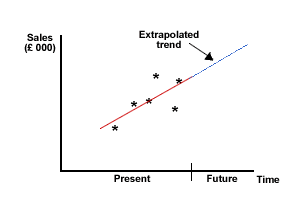Sales forecasting

Trends and extrapolation
When you are given figures in a case study or IB question on the development of a business, or results of marketing surveys, look for information that indicates an underlying pattern of growth or decline - referred to as a trend. Your task will be to analyse the movements and suggest reasons for the changes and most importantly, the consequences for the business.
In an IB examination, a question may ask you use the data you have been given to make predictions about future sales and profits. This process of using past data to predict the future is called extrapolation. To achieve this you will need to establish if there is an underlying trend below what may appear to be inconsistent past financial data. If you can find a trend, your next task will be to use this to predict the future - a business crystal ball! The problem is that, however scientific the process, the end result may be no more than a 'guestimate' and in practice may prove completely inaccurate - the future does not always resemble the past as events can rapidly change the status quo. You only have to consider the implosion of world economies from 2008 onwards to see how rapidly the external environment can change.
Figure 1 below shows a trend and an extrapolated trend.

Figure 1 Extrapolated trend
The diagram shows actual sales figures over a period, which appear to be inconsistent. However, we are able to produce a 'line of best fit' called the trend line. In figure 1, the trend points to improving sales in the future. This trend is established through the use of MOVING AVERAGES to smooth out the impact of variations in data. We will look in more detail at these in the next section (click on the right arrow at the top or bottom of the page to start having a look at this).
Forecasting future sales has several important applications. The firm can use this information to:
- Plan future production levels: this will allow for a more efficient use of the firm's resources, in particular labour which is normally a firm's highest cost. It will identify recruitment and training needs, or depressingly the requirement for redundancies.
- Improve cash flow and working capital: examining variations in sales and predicting future sales can help the firm plan for its liquidity and evaluate the need for additional sources of finance. Lenders will be more likely to supply additional funds if they can see that the firm will be able to repay on time.
- Improve stock control: accurate sales forecasts will underpin stock ordering and ensure that production has the raw materials when required. Stock represents is tied up cash, so maintaining the correct level of stock will also help liquidity.
- Drive marketing campaigns: the identification of key periods for company sales will allow the firm to plan effective marketing including distribution, pricing and promotion.
- Underpin the budgeting process: sales are a major driver of budgets.
- Want to identify significant trend: firms want to know what trends are emerging to make sure they can adapt their marketing or product portfolio to reflect this.
- Want to see if any seasonal factors affect their product: Customers enjoy strawberries more often than just in the summer, so the major supermarkets import from warmer climates. That way they can eat strawberries and cream 12 months of the year, but at a price.
- Want to identify the influence of economic cycles arise within the firm's demand patterns: is the firm's demand closely linked to the state of the economy?
